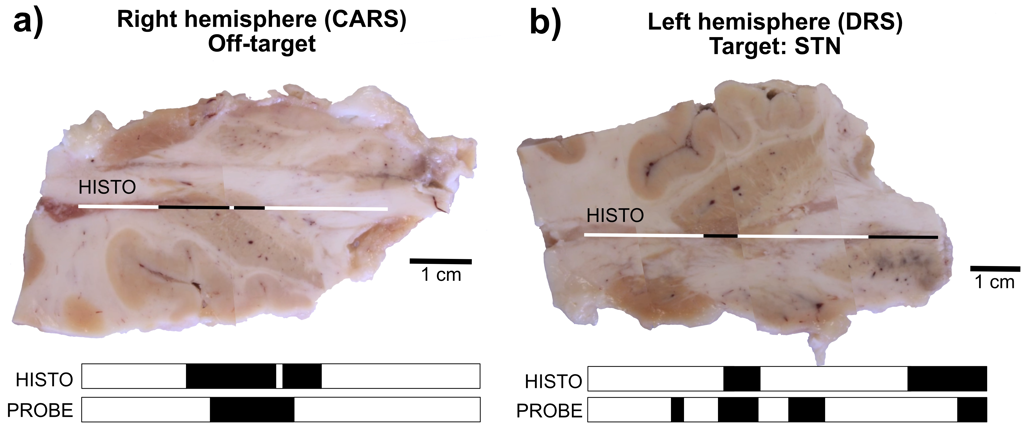Spectroscopy probe could enhance deep brain stimulation procedure for Parkinson’s
About Optica
15 March 2023
Spectroscopy probe could enhance deep brain stimulation procedure for Parkinson’s
Optical fibers provide real-time information to help doctors navigate inside the brain
VANCOUVER -- Deep brain stimulation (DBS) has become an increasingly common treatment for patients with advanced Parkinson’s disease, but the procedure still carries significant risks. A new probe that performs two types of spectroscopy could make the procedure safer and improve success rates by helping doctors more accurately navigate instruments inside the brain. The research team identified white and grey matter using principal component analysis (PCA), proving that spectroscopic measurements could be suitable for neuronavigation.
For DBS, surgeons place electrodes in the brain to disrupt the errant signals that cause debilitating tremors and stiffness associated with advanced Parkinson’s disease. It can be a remarkably effective treatment for patients who no longer benefit from available medications, but placing an electrode in the wrong spot can reduce the effectiveness and lead to psychological disorders.
Mireille Quémener from CERVO Brain Research Center (Université Laval) in Québec will detail the new research at Optica’s Biophotonics Congress being held in Vancouver, British Columbia and online 23 – 27 April 2023. Quémener’s presentation is scheduled for Thursday, 27 April at 12:15 PDT (UTC – 07:00).
“Improving neurosurgical guidance for the DBS electrode insertion would streamline the surgical process, decrease the surgery time, reduce the overall health treatment cost and prevent adverse neuropsychological consequences,” said Quémener.

Caption: Tissue slices of the left and right hemispheres showing two electrode insertions to (a) an off- target portion of the brain’s right hemisphere (using CARS), and (b) to the subthalamic nucleus (STN) of the brain’s left hemisphere (using DRS). Tissue types were visually identified from histological slices (HISTO) to generate a barcode composed of black (gray matter) and white (white matter) regions. This barcode is compared to the data acquired with the optical probe and analyzed using a PCA agorithm (PROBE barcode).
Credit: Mireille Quémener, Research Engineer from Prof. Daniel Côté’s lab at CERVO Brain Research Center (Université Laval). This project is funded by the Natural Sciences and Engineering Research Council of Canada (NSERC) and the Canadian Institutes of Health Research (CIHR).
Real-time navigation support
DBS is a two-part procedure, including one surgery to place electrodes in specific parts of the brain and a second surgery to implant a battery pack that delivers electrical current to the electrodes. For the first procedure, doctors typically rely on pre-surgery magnetic resonance imaging (MRI) scans to plan where they will insert electrodes. However, this can sometimes lead to an inaccurate placement since the brain can shift by up to 2 mm during the process of drilling an access hole through the skull.
In the new work, researchers created a DBS electrode that is enhanced with an optical probe to perform coherent anti-Stokes Raman scattering spectroscopy (CARS) and diffuse reflectance spectroscopy (DRS) on brain tissues during the insertion process. The probe fits within the DBS electrode and contains two fibers for CARS and DRS illumination and a third fiber for collecting the signals. Once the electrode reaches the target position, the optical probe can be while the electrode stays in place.
Confirming accuracy
To test the new probe, a neurosurgeon used it to implant electrodes in six regions of the brain of a human cadaver. CARS and DRS measurements were collected along a total length of 50 mm in each of the brain’s two hemispheres. After the procedure, researchers extracted the brain and visually identified the white and grey matter through which the probe had passed.
Comparing the readouts from the CARS and DRS measurements to the visual record of brain structures, the researchers found the CARS and DRS methods identified brain tissue with great accuracy. These findings confirm that spectroscopy could be a useful tool to help neurosurgeons navigate the brain.
The researchers plan to study whether the approach could be used to collect even more detailed spectroscopic information, for example to measure neurotransmitters that provide a chemical signature of brain activity.
“Our team is currently working on adapting the optical probe to use it in clinical trials for patients who will receive a DBS surgery. We are convinced that optical methods have enormous potential for surgical guidance, and hope that our technology will emerge in the clinic to assist surgeons in various brain procedures,” said Quémener.
About Optica Biophotonics Congress
Optica Biophotonics Congress is an annual meeting that focuses on biomedical optics and optics in the life sciences in alternating years. The 2023 meeting, Optica Biophotonics Congress: Optics in the Life Sciences, explores the latest tools and techniques in optical imaging with a focus on advanced techniques for microscopic imaging and related applications. The meeting will be presented in a hybrid conference format with in-person and virtual participation options. More information at https://www.optica.org/en-us/events/congress/biophotonics_congress/.
About Optica
Optica, Advancing Optics and Photonics Worldwide, is the society dedicated to promoting the generation, application, archiving and dissemination of knowledge in the field. Founded in 1916, it is the leading organization for scientists, engineers, business professionals, students and others interested in the science of light. Optica's renowned publications, meetings, online resources and in-person activities fuel discoveries, shape real-life applications and accelerate scientific, technical and educational achievement. Discover more at: Optica.org
Media Contact
